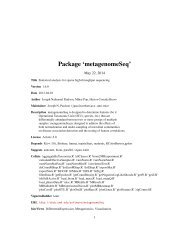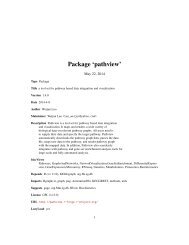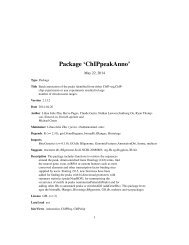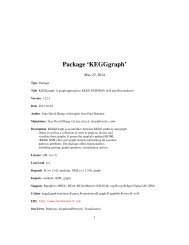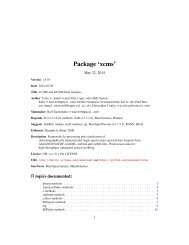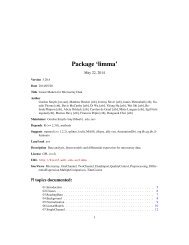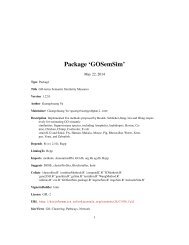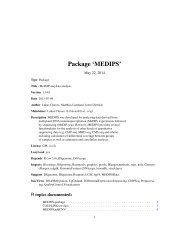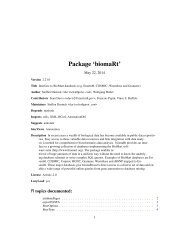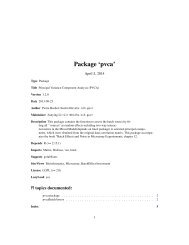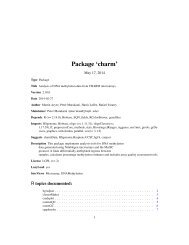Package 'SSPA' - Bioconductor
Package 'SSPA' - Bioconductor
Package 'SSPA' - Bioconductor
You also want an ePaper? Increase the reach of your titles
YUMPU automatically turns print PDFs into web optimized ePapers that Google loves.
<strong>Package</strong> ‘SSPA’<br />
May 22, 2014<br />
Type <strong>Package</strong><br />
Title General Sample Size and Power Analysis for Microarray and Next-Generation Sequencing Data<br />
Version 2.4.0<br />
Author Maarten van Iterson<br />
Maintainer Maarten van Iterson <br />
Description General Sample size and power analysis for microarray and<br />
next-generation sequencing data.<br />
License GPL (>= 2)<br />
LazyLoad yes<br />
Imports graphics, stats<br />
Depends R (>= 2.12), methods, qvalue, lattice, limma<br />
Suggests BiocStyle, genefilter, edgeR, DESeq<br />
URL http://www.humgen.nl/MicroarrayAnalysisGroup.html<br />
Collate 'zzz.R' 'numericalintegration.R' 'trimmingbinning.R'<br />
'DistributionClass.R' 'PilotDataClass.R' 'SampleSizeClass.R'<br />
'bitriangular.R' 'deconvolution.R' 'conjugategradient.R'<br />
'Ferreira.R' 'tikhonov.R' 'powerandsamplesize.R'<br />
biocViews Microarray, StatisticalMethod<br />
R topics documented:<br />
dbitri . . . . . . . . . . . . . . . . . . . . . . . . . . . . . . . . . . . . . . . . . . . . . 2<br />
deepSAGE . . . . . . . . . . . . . . . . . . . . . . . . . . . . . . . . . . . . . . . . . 3<br />
Nutrigenomics . . . . . . . . . . . . . . . . . . . . . . . . . . . . . . . . . . . . . . . . 3<br />
pbitri . . . . . . . . . . . . . . . . . . . . . . . . . . . . . . . . . . . . . . . . . . . . . 4<br />
pilotData . . . . . . . . . . . . . . . . . . . . . . . . . . . . . . . . . . . . . . . . . . 5<br />
plot-methods . . . . . . . . . . . . . . . . . . . . . . . . . . . . . . . . . . . . . . . . 6<br />
1
2 dbitri<br />
predictpower . . . . . . . . . . . . . . . . . . . . . . . . . . . . . . . . . . . . . . . . 6<br />
qbitri . . . . . . . . . . . . . . . . . . . . . . . . . . . . . . . . . . . . . . . . . . . . . 7<br />
rbitri . . . . . . . . . . . . . . . . . . . . . . . . . . . . . . . . . . . . . . . . . . . . . 7<br />
sampleSize . . . . . . . . . . . . . . . . . . . . . . . . . . . . . . . . . . . . . . . . . 8<br />
show-methods . . . . . . . . . . . . . . . . . . . . . . . . . . . . . . . . . . . . . . . . 11<br />
simdat . . . . . . . . . . . . . . . . . . . . . . . . . . . . . . . . . . . . . . . . . . . . 11<br />
Index 13<br />
dbitri<br />
Density function for a bi-triangular random variable.<br />
Description<br />
Density function for a bi-triangular random variable.<br />
Usage<br />
dbitri(x, a = log2(1.2), b = log2(4), m = log2(2))<br />
Arguments<br />
x<br />
a<br />
b<br />
m<br />
vector<br />
location of point ... Default a = log2(1.2).<br />
location of point ... Default b = log2(4).<br />
location of the midpoint of the triangle. Default m = log2(2).<br />
Details<br />
For more details see M. Langaas et al. JRSS B 2005.<br />
Value<br />
Gives the density function.<br />
Author(s)<br />
Maarten van Iterson<br />
Examples<br />
curve(dbitri, -4, 4)
deepSAGE 3<br />
deepSAGE<br />
Test statistics derived from a deepSAGE experiment<br />
Description<br />
follow<br />
Usage<br />
data(deepSAGE)<br />
Format<br />
A vector of 44882 test statistics.<br />
Vector of test statistics obtained by performing a likelihood ratio test using edgeR<br />
Details<br />
follow<br />
Source<br />
’t Hoen, P.A.C. Ariyurek, Y. Thygesen, H.H. Vreugdenhil, E. Vossen, R.H.A.M. de Menezes, R.X.<br />
Boer, J.M. van Ommen, G.B. and den Dunnen, J.T., Deep Sequencing-based Expression analysis<br />
shows Major Advances in Robustness, Resolution and Inter-lab Portability over Five Microarray<br />
Platforms, Nucleic Acids Research, 2008.<br />
Examples<br />
data(deepSAGE)<br />
str(deepSAGE)<br />
Nutrigenomics<br />
Test statistics from a Nutrigenomics gene expression profiling experiment<br />
Description<br />
There are five sets of test statistics each represents a different compound and exposure time. Test<br />
statistics were obtained by using an empirical Bayes linear model.<br />
Usage<br />
data(Nutrigenomics)
4 pbitri<br />
Format<br />
A data frame with 16539 test statistics for five experiments.<br />
First row indicates the effective sample size of the experiment. Column names refer to the<br />
compound and exposure time (see details).<br />
Details<br />
In this experiment the outcome of specific PPAR-alpha activation on murine small intestinal gene<br />
expression was examined using Affymetrix GeneChip Mouse 430 2.0 arrays. PPAR-alpha was<br />
activated by several PPAR-alpha-agonists that differed in activating potency. In this paper the data<br />
of three agonists were used, namely Wy14,643, fenofibrate and trilinolenin (C18:3). The first two<br />
compounds belong to the fibrate class of drugs that are widely prescribed to treat dyslipidemia,<br />
whereas trilinolenin is an agonist frequently found in the human diet. For intestinal PPAR-alpha,<br />
Wy14,643 is the most potent agonist followed by C18:3 and fenofibrate. Since time of exposure<br />
also affects the effect size, intestines were collected 6 hrs (all three agonists) or 5 days (Wy14,643<br />
and fenofibrate only) after exposure.<br />
Source<br />
van Iterson, M. ’t Hoen, P.A.C. Pedotti, P. Hooiveld, G.J.E.J. den Dunnen, J.T. van Ommen, G.J.B.<br />
Boer, J.M. Menezes, R.X., Relative power and sample size analysis on gene expression profiling<br />
data, BMC Genomics, (2009).<br />
Examples<br />
data(Nutrigenomics)<br />
str(Nutrigenomics)<br />
pbitri<br />
Distribution function for a bi-triangular random variable.<br />
Description<br />
Distribution function for a bi-triangular random variable.<br />
Usage<br />
pbitri(q, a = log2(1.2), b = log2(4), m = log2(2))<br />
Arguments<br />
q<br />
a<br />
b<br />
m<br />
vector of quantiles.<br />
location of point, ... Default a = log2(1.2).<br />
location of point, ... Default b = log2(4).<br />
location of the midpoint of the triangle. Default m = log2(2).
pilotData 5<br />
Details<br />
For more details see M. Langaas et al. JRSS B 2005.<br />
Value<br />
Gives the distribution function.<br />
Author(s)<br />
Maarten van Iterson<br />
Examples<br />
curve(pbitri, -4, 4)<br />
pilotData<br />
User friendly interface to class "PilotData"<br />
Description<br />
Usage<br />
User friendly interface to class "PilotData"<br />
Arguments<br />
Details<br />
Value<br />
pilotData(statistics = NULL, samplesize = NULL,<br />
distribution = c("norm", "t", "f", "chisq"), ...)<br />
statistics<br />
samplesize<br />
distribution<br />
vector of test statistics<br />
total sample size of the pilot-data or effective sample size in two-group case (see<br />
Details for more information).<br />
type of the null/alternative distribution, one of ’norm’, ’t’, ’f’ or ’chisq’<br />
... additional arguments for the distribution like degrees of freedom<br />
In the two-group case the effective sample size is defined as the square-root of the inverse of 1/n1 +<br />
1/n2.<br />
object of class "PilotData"<br />
Author(s)<br />
Maarten van Iterson
6 predictpower<br />
Examples<br />
pd
qbitri 7<br />
qbitri<br />
Quantile function for a bi-triangular random variable.<br />
Description<br />
Quantile function for a bi-triangular random variable.<br />
Usage<br />
qbitri(p, a = log2(1.2), b = log2(4), m = log2(2))<br />
Arguments<br />
p<br />
a<br />
b<br />
m<br />
vector of probabilities.<br />
location of point, ... Default a = log2(1.2).<br />
location of point, ... Default b = log2(4).<br />
location of the midpoint of the triangle. Default m = log2(2).<br />
Details<br />
For more details see M. Langaas et al. JRSS B 2005.<br />
Value<br />
Gives the quantile function.<br />
Author(s)<br />
Maarten van Iterson<br />
Examples<br />
curve(qbitri, 0, 1)<br />
rbitri<br />
Random generation of bitriangular distributed values.<br />
Description<br />
Random generation of bitriangular distributed values.<br />
Usage<br />
rbitri(n, a = log2(1.2), b = log2(4), m = log2(2))
8 sampleSize<br />
Arguments<br />
n<br />
a<br />
b<br />
m<br />
number of observations.<br />
location of point, ... Default a = log2(1.2).<br />
location of point, ... Default b = log2(4).<br />
location of the midpoint of the triangle. Default m = log2(2).<br />
Details<br />
For more details see M. Langaas et al. JRSS B 2005.<br />
Value<br />
Generates random deviates.<br />
Author(s)<br />
Maarten van Iterson<br />
Examples<br />
hist(rbitri(100), freq=FALSE)<br />
curve(dbitri, add=TRUE)<br />
sampleSize<br />
User friendly interface to class ’SampleSize’<br />
Description<br />
User friendly interface to class "SampleSize"<br />
Usage<br />
sampleSize(PilotData,<br />
method = c("deconv", "congrad", "tikhonov", "ferreira"),<br />
control = list(from = -6, to = 6, resolution = 2^9))<br />
Arguments<br />
PilotData<br />
method<br />
control<br />
object of class ’PilotData’.<br />
estimation method one of ’deconv’, ’congrad’, ’tikhonov’ or ’ferreira’. See ’Details’.<br />
A list of control parameters. See ’Details’.
sampleSize 9<br />
Details<br />
The default method is ’deconv’ which is an kernel deconvolution density estimator implementated<br />
using fft. The ’nncg’ is a nonnegative conjugate gradient algorithm based on R’s implementation<br />
see optim. ’tikonov’ implements ridge-regression with optimal penalty selection using the L-curve<br />
approach. Higher order penalties are possible as well using a transformation to standard form (see<br />
Hansen).<br />
The ’control’ argument is a list that can supply any of the following components. Per method logical<br />
checks are performed.<br />
• deconv:<br />
– method:’deconv’, ’ferreira’<br />
– pi0Method:the pi0 estimation method one of ’Langaas’, ’Storey’, ’Ferreira’, ’Userdefined’<br />
– pi0:if method = ’ferreira’ grid pi0-value need to be suppled e.g. seq(0.1, 0.99, 0.01)<br />
– adjust:Default TRUE, adjust pi0 esitmate if density of effect size is somewhere negative.<br />
– a:Adjust pi0 better approach suggested by Efron. Symmetric range around zero of size<br />
0.5.<br />
– bandwith:Default NULL uses 1/sqrt(log(length(statistics)))<br />
– kernel:Either ’fan’, ’wand’, ’sinc’ kernels can be used.<br />
– from:Density of effect sizes should be estimated from = -6<br />
– to: to = 6<br />
– resolution:Density of effect sizes should be estimated on 2^9 points.<br />
– verbose:Default FALSE if TRUE additional information is printed to the console.<br />
• congrad:<br />
– integration:’midpoint’, ’trapezoidal’, ’simpson’<br />
– scale:’pdfstat’, ’cdfstat’, ’cdfpval’<br />
– trim:0.01, 0.99<br />
– symmetric:TRUE<br />
– bin:’epdf’, ’ecdf’<br />
– from:-6<br />
– to:6<br />
– resolution:500<br />
– verbose:Default FALSE if TRUE additional information is printed to the console.<br />
• tikhonov:<br />
– integration:’midpoint’, ’trapezoidal’, ’simpson’<br />
– scale:’pdfstat’, ’cdfstat’, ’cdfpval’<br />
– trim:0.01, 0.99<br />
– symmetric:TRUE<br />
– bin:’epdf’, ’ecdf’<br />
– from:-6<br />
– to:6<br />
– resolution:500
10 sampleSize<br />
Value<br />
– method:’lcurve’, ’gcv’, ’aic’<br />
– log:TRUE<br />
– penalty:0<br />
– lambda:10^seq(-10, 10, length=100)<br />
– verbose:Default FALSE if TRUE additional information is printed to the console.<br />
• ’ferreira:’not yet implemeneted<br />
object of class SampleSize.<br />
Author(s)<br />
Maarten van Iterson<br />
References<br />
van Iterson, M., P. ’t Hoen, P. Pedotti, G. Hooiveld, J. den Dunnen, G. van Ommen, J. Boer, and R.<br />
de Menezes (2009): ’Relative power and sample size analysis on gene expression profiling data,’<br />
BMC Genomics, 10, 439–449.<br />
Ferreira, J. and A. Zwinderman (2006a): ’Approximate Power and Sample Size Calculations with<br />
the Benjamini-Hochberg Method,’ The International Journal of Biostatistics, 2, 1.<br />
Ferreira, J. and A. Zwinderman (2006b): ’Approximate Sample Size Calculations with Microarray<br />
Data: An Illustration,’ Statistical Applications in Genetics and Molecular Biology, 5, 1.<br />
Hansen, P. (2010): Discrete Inverse Problems: Insight and Algorithms, SIAM: Fun- damentals of<br />
algorithms series.<br />
Langaas, M., B. Lindqvist, and E. Ferkingstad (2005): ’Estimating the proportion of true null<br />
hypotheses, with application to DNA microarray data,’ Journal of the Royal Statistical Society<br />
Series B, 67, 555–572.<br />
Storey, J. (2003): ’The positive false discovery rate: A bayesian interpretation and the q-value,’<br />
Annals of Statistics, 31, 2013–2035.<br />
See Also<br />
optim<br />
Examples<br />
m
show-methods 11<br />
show-methods<br />
General show method for Classes PilotData and SampleSize<br />
Description<br />
Methods for function show in package SSPA<br />
Methods<br />
signature(object = "PilotData") Show the content of a PilotData-object in a userfriendly<br />
way.<br />
signature(object = "SampleSize") Show the content of a SampleSize-object in a userfriendly<br />
way.<br />
simdat<br />
Generate simulated microarray data using the bitriangular distribution.<br />
Description<br />
Usage<br />
Simulated microarray data.<br />
Arguments<br />
mu<br />
simdat(mu, m, pi0, J, nullX = function(x) rnorm(x, 0, 1),<br />
nullY = function(x) rnorm(x, 0, 1), noise = 0.01)<br />
vector of effect sizes drawn from the bitriangular distribution.<br />
m number of features (genes, tags, ...).<br />
pi0<br />
J<br />
Details<br />
Value<br />
nullX<br />
nullY<br />
noise<br />
details follow<br />
proportion of nondifferentially expressed features.<br />
number of samples per group.<br />
the distribution of nondifferentially expressed features.<br />
the distribution of nondifferentially expressed features.<br />
standard deviation of the additive noise.<br />
Matrix of size m x (2J), containing the simulated values.
12 simdat<br />
Author(s)<br />
Maarten van Iterson<br />
Examples<br />
##generate two-group microarray data<br />
m
Index<br />
∗Topic datasets<br />
deepSAGE, 3<br />
Nutrigenomics, 3<br />
∗Topic methods<br />
plot-methods, 6<br />
show-methods, 11<br />
dbitri, 2<br />
deepSAGE, 3<br />
fft, 9<br />
Nutrigenomics, 3<br />
optim, 9, 10<br />
pbitri, 4<br />
pilotData, 5<br />
plot,ANY-method (plot-methods), 6<br />
plot,PilotData-method (plot-methods), 6<br />
plot,SampleSize-method (plot-methods), 6<br />
plot-methods, 6<br />
predictpower, 6<br />
qbitri, 7<br />
rbitri, 7<br />
sampleSize, 8<br />
show,ANY-method (show-methods), 11<br />
show,PilotData-method (show-methods), 11<br />
show,SampleSize-method (show-methods),<br />
11<br />
show-methods, 11<br />
simdat, 11<br />
13



